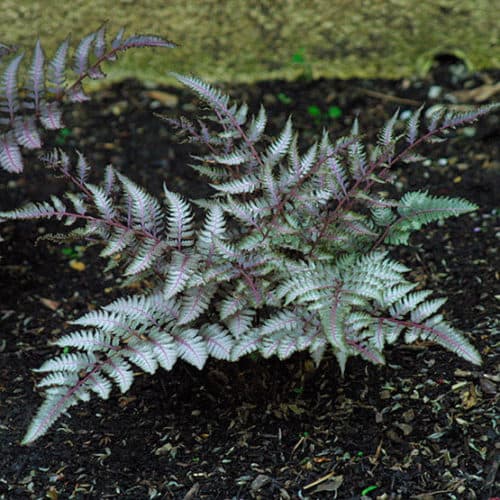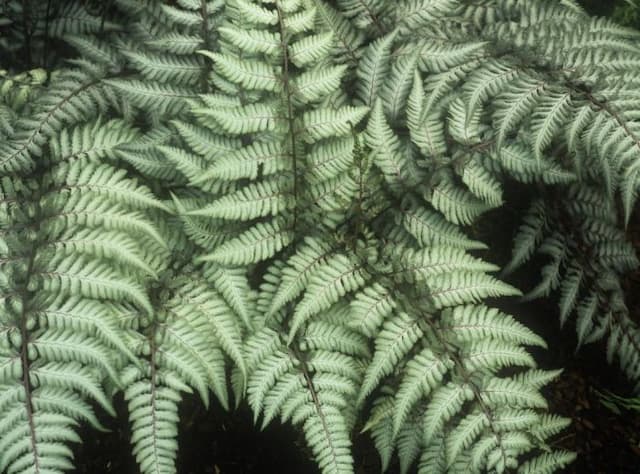Japanese Painted Fern Athyrium niponicum

ABOUT
Athyrium niponicum, commonly known as Japanese painted fern, is recognized for its distinctive and attractive foliage. The fronds of this fern are its standout feature, boasting a remarkable blend of colors. The leaves are typically a soft grayish-green, overlaid with hues of silvery-blue and rich, contrasting maroon or purplish-red veining. Each frond is divided into smaller leaflets that are intricately subdivided, giving the plant a delicate and feathery appearance. The leaflets are arranged in a manner that gives the frond a ladder-like look, with each leaflet gently arching downwards. The Japanese painted fern's stems, or stipes, echo the coloration of the veins, often displaying a similar maroon or purple tone that adds to the visual intrigue of the plant. As the fronds unfurl in a vase-shaped cluster, they create a substantial and textured display that can add both color and elegance to shady garden areas or woodland settings. Without discussing its specific dimension, the plant's overall form and the finely detailed fronds make it a popular choice amongst garden enthusiasts who seek to add a touch of grace and a palette of cool colors to a landscape.
About this plant
 Names
NamesFamily
Athyriaceae
Synonyms
Japanese Painted Fern, Painted Fern, Japanese Lady Fern
Common names
Athyrium goeringianum, Asplenium niponicum
 Toxicity
ToxicityTo humans
Japanese Painted Fern (Athyrium niponicum) is generally considered non-toxic to humans. There is no widely known toxicity associated with this plant, and it is commonly grown for ornamental purposes. Ingesting the plant is unlikely to cause any significant symptoms or consequences, but as with any non-food plant, consumption is not recommended and could potentially result in stomach irritation or discomfort due to natural plant compounds.
To pets
Japanese Painted Fern (Athyrium niponicum) is not known to be toxic to pets such as dogs and cats. It is often used in gardens and landscaping without posing a risk to animals. If a pet were to ingest this fern, it is unlikely to suffer from any serious symptoms of poisoning; however, ingestion of non-food plants can sometimes lead to mild gastrointestinal upset, such as vomiting or diarrhea, due to the plant's fiber and different plant compounds.
 Characteristics
CharacteristicsLife cycle
Perennials
Foliage type
Deciduous
Color of leaves
Variegated
Height
1-2 feet (30-60 cm)
Spread
1-3 feet (30-90 cm)
Plant type
Fern
Hardiness zones
4
Native area
Japan
Benefits
 General Benefits
General Benefits- Ornamental appeal: Athyrium niponicum, commonly known as Japanese painted fern, adds a unique aesthetic to gardens with its silver-grey foliage highlighted by shades of blue and purple.
- Shade tolerance: This fern is well-suited for shaded areas in the garden where other plants might not thrive, making it an excellent choice for filling in dark spots with foliage.
- Low maintenance: Once established, Japanese painted fern requires minimal care, adapting to a variety of soil types and needing only occasional watering during dry periods.
- Drought resistance: Once it is established, the fern is relatively drought-tolerant, although it prefers a consistently moist environment.
- Deer and rabbit resistant: The fern is typically not favored by deer or rabbits, making it a good choice for gardens in areas prone to wildlife browsing.
- Soil erosion control: Its spreading habit and dense root system can help stabilize soil in shaded areas, reducing erosion on slopes or in areas with loose soil.
 Medical Properties
Medical PropertiesThis plant is not used for medical purposes.
 Air-purifying Qualities
Air-purifying QualitiesThis plant is not specifically known for air purifying qualities.
 Other Uses
Other Uses- Athyrium niponicum, commonly known as the Japanese painted fern, can be used in artistic compositions such as Ikebana, the Japanese art of flower arrangement, where its unique foliage and color provide a contrast to flowers.
- Its fronds can be pressed and used in botanical prints or herbarium collections, serving as a decorative element for educational purposes or art.
- The textured fronds of the Japanese painted fern can be used in craft projects, like making bookmarks or greeting cards, to add a natural touch.
- This plant can be employed as a living mulch in gardens to suppress weeds due to its dense and spreading foliage.
- It can be used in shaded landscape designs as a backdrop for highlighting brighter-colored plants or flowers within a garden.
- Educational projects often use Athyrium niponicum to demonstrate fern reproduction and the life cycle of non-flowering plants to students.
- For photographers, the Japanese painted fern provides an interesting subject for macro photography due to its intricate leaf patterns and colors.
- Athyrium niponicum can be used in terrariums or fairy gardens, creating a miniature woodland scene due to its small stature and forest-like appearance.
- The fern can be part of sensory gardens, offering a soft texture to be touched and visually soothing greenery for sensory enrichment.
- Lastly, its distinctive foliage can be used in costume design, where elements of nature are desired to be incorporated into the outfits.
Interesting Facts
 Feng Shui
Feng ShuiThe Japanese Painted Fern is not used in Feng Shui practice.
 Zodiac Sign Compitability
Zodiac Sign CompitabilityThe Japanese Painted Fern is not used in astrology practice.
 Plant Symbolism
Plant Symbolism- Elegance: The delicate fronds and subtle variegation of the Japanese Painted Fern, as it is commonly known, symbolize elegance and a refined aesthetic sense.
- Endurance: Despite its fragile appearance, this fern is quite resilient and is able to thrive in shady gardens, thereby representing endurance and the ability to thrive in less than ideal conditions.
- Peaceful Retreat: The Japanese Painted Fern is often found in serene garden settings, symbolizing tranquility and the creation of a peaceful hideaway.
- New Beginnings: Ferns in general are frequently associated with new growth and fresh starts, making the Japanese Painted Fern a symbol of rebirth and new beginnings.
- Secret Bond: The intricate patterns of its leaves can represent the complexity of relationships, symbolizing a secret bond or hidden knowledge shared between close friends.
 Water
WaterThe Japanese Painted Fern prefers consistently moist soil and should be watered thoroughly once the top inch of soil feels dry to the touch. Depending on the climate and the environment, this could mean watering every few days to once a week. When watering, aim for a deep soak which reaches the roots, providing about half a gallon for a medium-sized fern every time you water. Adjust the frequency during hot, dry periods by increasing to two or three times a week and reduce accordingly during cooler, wetter seasons.
 Light
LightJapanese Painted Ferns thrive best in partial to full shade, where bright, indirect sunlight can filter through. They should be placed in a location where the intense afternoon sun is avoided to prevent scorching of their delicate fronds. A spot under the canopy of taller trees or on the north side of a building would be ideal, where they can receive dappled light.
 Temperature
TemperatureJapanese Painted Ferns grow best in cooler temperatures ranging from 60 to 70 degrees Fahrenheit. They can tolerate minimum temperatures down to about 50 degrees Fahrenheit and maximum which should ideally not exceed 80 degrees Fahrenheit. Keeping them in conditions outside of this range for prolonged periods can stress the plant.
 Pruning
PruningPruning the Japanese Painted Fern is mainly for aesthetic purposes and removal of any dead or damaged fronds. This can be done in early spring, just before new growth begins. Annual trimming helps to encourage healthy new fronds and maintains a tidy appearance. These ferns do not require frequent pruning; once a year is usually sufficient.
 Cleaning
CleaningAs needed
 Soil
SoilThe Japanese Painted Fern prefers a soil mix that is well-draining but consistently moist. A combination of garden soil, compost, and a small portion of perlite or coarse sand works well to facilitate drainage while retaining appropriate moisture. The best pH range for this plant is slightly acidic to neutral, around pH 6.0 to 7.0.
 Repotting
RepottingJapanese Painted Ferns should be repotted every 2 to 3 years. It's best to repot them in the spring before they enter a period of active growth. This timeline can vary depending on whether the fern becomes root-bound or the soil loses its structure and nutrient content.
 Humidity & Misting
Humidity & MistingJapanese Painted Ferns thrive at high humidity levels, ideally around 60-70%. Providing a humid environment is essential for the fronds to look their best and to mimic the fern's natural habitat.
 Suitable locations
Suitable locationsIndoor
Place in bright, indirect light and ensure high humidity for growth.
Outdoor
Plant in shade to part shade; keep soil moist, not waterlogged.
Hardiness zone
4-9 USDA.
 Life cycle
Life cycleJapanese painted fern, Athyrium niponicum, begins its life cycle as a spore released from the undersides of mature fern fronds. When conditions are favorable with moisture and shade, the spores germinate to produce a heart-shaped gametophyte, which is the sexual stage. The gametophyte houses both the male and female reproductive parts and, upon fertilization, gives rise to a new sporophyte—the recognizable fern plant. This young fern, initially a tiny rosette, gradually develops into a mature fern with arching, silver-grey and purple fronds, completing its vegetative growth stage. In the reproductive stage, the mature fern produces fertile fronds with sori containing spores on their undersides, ready to disperse and start the cycle anew. Throughout its life, the Japanese painted fern thrives in cool, moist, and shaded environments, often going dormant in winter and resurging in spring.
 Propogation
PropogationPropogation time
Spring to Summer
The Japanese painted fern, Athyrium niponicum, is typically propagated through division, which is a straightforward and popular method. The best time for dividing Japanese painted ferns is in spring as the new fronds start to emerge. This timing allows the plant to recover and establish itself during the growing season. To propagate by division, carefully dig up the parent plant, ensuring to keep a good portion of the root system intact for each division. Each section should have at least one growing crown with attached roots. The divisions can then be immediately replanted in a shaded area with moist, well-draining soil. By maintaining consistent moisture and avoiding direct sunlight, the new plants should establish and grow effectively over the following months.




